4237
Fast Measurement of B1+ using the NO2RAGE pulse sequence1NMR Unit, Max Planck Institute for Human Cognitive and Brain Sciences, Leipzig, Germany, 2Department of Neurophysics, Max Planck Institute for Human Cognitive and Brain Sciences, Leipzig, Germany
Synopsis
The knowledge of the spatial distribution of the transmit field of the coil, B1+, is essential in a number of MRI applications, particularly at higher field strength. SA2RAGE is a recently developed technique for B1+ mapping, derived from the MP2RAGE scheme. The sensitivity to B1+ is obtained from a preparation pulse and optimized delays between block gradient acquisitions. Here, we propose a much faster (but otherwise comparable) method, referred to as NO2RAGE, where the B1+ sensitivity is obtained by omitting the preparation, nullifying the delays, and adjusting the other sequence parameters. The technique compares favorably against other in vivo methods.
Purpose
A number of MRI applications require precise knowledge of the transmit field of the coil, $$$B_1^+$$$. For example, FLASH-based $$$T_1$$$ mapping techniques are typically corrected with $$$B_1^+$$$ maps for obtaining accurate voxel-wise information of the flip-angles1. This is especially true at higher fields because the increasingly shorter wavelength of the radio-frequency field degrades the homogeneity $$$B_1^+$$$. Recently, the SA2RAGE sequence has been proposed as a fast technique for obtaining $$$B_1^+$$$ maps2 . This method employs a pulse sequence scheme similar to MP2RAGE, where the preparation is now aiming at obtaining $$$B_1^+$$$ sensitivity while being simultaneously insensitive to $$$T_1$$$. For low resolution maps, relatively good performance can be obtained by optimizing the acquisition parameters, especially the delays between block gradient acquisitions. However, this method loses efficacy at higher resolutions. Here, we propose a novel variation of the MP2RAGE scheme: No preparatiOn 2 RApid Gradient Echo (NO2RAGE), which is a highly time efficient modification achieving significantly higher resolution within shorter acquisition times. This is obtained by omitting the preparation pulse, reducing all delays to minimum and adjusting the other sequence parameters accordingly.Methods
The NO2RAGE pulse sequence, shown in Fig.[1] was obtained from an MP2RAGE pulse sequence with omitted preparation. The signal at the two gradient echo blocks is calculated from the solution of the Bloch equations3. Their ratio $$$\rho=\frac{s_1}{s_2}$$$ is a function of $$$B_1^+$$$ (expressed in terms of the flip-angle efficiency $$$\eta_\alpha\equiv\frac{\alpha_\mathrm{actual}}{\alpha_\mathrm{nominal}}$$$), $$$T_1$$$ and other sequence parameters. The sensitivity to $$$B_1^+$$$ as well as the insensitivity to $$$T_1$$$ is assessed by plotting $$$B_1^+$$$ as a function of $$$\rho$$$ for varying $$$T_1$$$ values. The same relation can be used to determine $$$B_1^+$$$ from the measured $$$\rho$$$ via a look-up table approach. Some sequence parameter simulations, as well as a comparison to SA2RAGE, are presented in Fig.[2]. $$$B_1^+$$$ ($$$\eta_\alpha$$$) maps of the full brain were acquired in the same session in a healthy volunteer (24, f) on a MAGNETOM 7T (Siemens, Erlangen, Germany) and a circularly-polarized Tx / 32-channel Rx Nova coil. $$$1\;\mathrm{mm}$$$ and $$$2\;\mathrm{mm}$$$ resolution NO2RAGE maps were validated against $$$4\;\mathrm{mm}$$$ resolution Actual Flip Angle (AFI)4, Spin Echo Echo-Planar Imaging (EPI) based5 and SA2RAGE2 acquisitions with identical Field-Of-View (FOV). Since the acquisitions were obtained from the same session, no registration was deemed necessary, given the relatively coarse resolution of the maps. The reproducibility was assessed with voxel-wise 2D histograms, difference images and related statistics. The NO2RAGE images were median-filtered and corrected for Rician noise bias6 before calculating $$$B_1^+$$$ maps.Results
The NO2RAGE $$$B_1^+$$$ maps are reported in Fig.[3]. The comparison against AFI, EPI-based and SA2RAGE acquisitions (after upscaling to $$$2\;\mathrm{mm}$$$ resolution) is shown in Fig.[4]. All maps show a near identical $$$B_1^+$$$ profile and their exact value match very well. NO2RAGE average deviates $$$\approx\pm{}2\%$$$ of both AFI and EPI-based maps. The acquisition time for the tested resolutions, as well as the required acquisition time for matching the NO2RAGE resolution is reported in Fig.[5]. The NO2RAGE pulse sequence is substantially faster than any of the considered methods.Discussion
The NO2RAGE pulse sequence yield higher resolution $$$B_1^+$$$ maps at shorter acquisition times, compared to the considered sequences. However, the NO2RAGE maps show more anatomical details than some of their counterparts. It is unclear whether this is related to the higher resolution or a residual $$$T_1$$$ weighting. The median-filter and the Rician noise bias correction help NO2RAGE obtain more accurate results in regions with low SNR and correspondingly low $$$B_1^+$$$ values.
The quantification of the potential residual $$$T_1$$$ weighting is difficult because all the tested methods suffer from it to some extent, and further simulations may be required to investigate this aspect. The more favorable behavior of $$$\rho$$$ for higher resolution (or longer gradient echo blocks) of NO2RAGE versus SA2RAGE makes NO2RAGE ideal for a multi-echo extension (similar to ME-MP2RAGE7). The multi-echo extension may allow for simultaneous acquisition of $$$B_1^+$$$ and $$$B_0$$$ (from the phase evolution of one of the two blocks) with sufficient resolution for many applications within very competitive acquisition times (although the longer $$$T_R$$$ within the gradient echo blocks may increase the $$$T_1$$$ sensitivity).
The computation of the maps is fast and simple for all tested acquisitions, possibly with the exception of the EPI-based method which, unlike the others, additionally requires a $$$B_0$$$ acquisition for geometric corrections.
Conclusion
The NO2RAGE pulse sequence allows for obtaining higher resolution $$$B_1^+$$$ maps of similar quality and within shorter acquisition times, when compared with some popular $$$B_1^+$$$ methods. By extending the gradient echo to include multiple echoes, it holds the potential of easily acquiring $$$B_1^+$$$ and $$$B_0$$$ simultaneously.Acknowledgements
We would like to thank the following people for insightful discussions: Tobias Leutritz, André Pampel and Toralf Mildner.
Funded by: EU through the 'HiMR' Marie Curie ITN (FP7-PEOPLE-2012-ITN-316716), the Max Planck Society through IMPRS NeuroCom, and the Helmholtz Alliance 'ICEMED - Imaging and Curing Environmental Metabolic Diseases'.
References
- Helms, G., Dathe, H., Weiskopf, N., Dechent, P., 2011. Identification of signal bias in the variable flip angle method by linear display of the algebraic ernst equation. Magn. Reson. Med. 66, 669–677. doi:10.1002/mrm.22849
- Eggenschwiler, F., Kober, T., Magill, A.W., Gruetter, R., Marques, J.P., 2012. SA2RAGE: A new sequence for fast B1+-mapping. Magnetic Resonance Medicine 67, 1609–1619. doi:10.1002/mrm.23145
- Marques, J.P., Kober, T., Krueger, G., van der Zwaag, W., Van de Moortele, P.-F., Gruetter, R., 2010. MP2RAGE, a self bias-field corrected sequence for improved segmentation and T1-mapping at high field. NeuroImage 49, 1271–1281. doi:10.1016/j.neuroimage.2009.10.002
- Yarnykh, V.L., 2007. Actual flip-angle imaging in the pulsed steady state: A method for rapid three-dimensional mapping of the transmitted radiofrequency field. Magn. Reson. Med. 57, 192–200. doi:10.1002/mrm.21120
- Jiru, F., Klose, U., 2006. Fast 3D radiofrequency field mapping using echo-planar imaging. Magn. Reson. Med. 56, 1375–1379. doi:10.1002/mrm.21083
- Gudbjartsson, H., Patz, S., 1995. The Rician Distribution of Noisy MRI Data. Magn Reson Med 34, 910–914.
- Metere, R., Kober, T., Möller, H.E., Schäfer, A., 2017. Simultaneous Quantitative MRI Mapping of T1, T2* and Magnetic Susceptibility with Multi-Echo MP2RAGE. PLOS ONE 12, e0169265. doi:10.1371/journal.pone.0169265
- Lutti, A., Stadler, J., Josephs, O., Windischberger, C., Speck, O., Bernarding, J., Hutton, C., Weiskopf, N., 2012. Robust and Fast Whole Brain Mapping of the RF Transmit Field B1 at 7T. PLOS ONE 7, e32379. doi:10.1371/journal.pone.0032379
- Hornak, J.P., Szumowski, J., Bryant, R.G., 1988. Magnetic field mapping. Magn. Reson. Med. 6, 158–163. doi:10.1002/mrm.1910060204
Figures
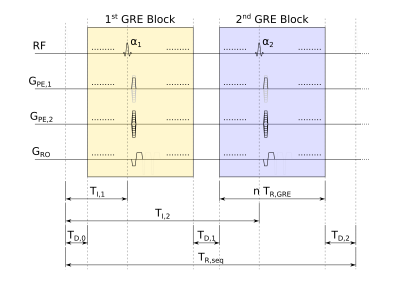
Fig.1: NO2RAGE pulse sequence diagram.
The pulse sequence is derived from MP2RAGE / SA2RAGE with the omission of the preparation pulse (depicted in very light gray). For optimal results, the GRadient Echo (GRE) block delays $$$T_{D,i}$$$ are reduced to a minimum. This setting both achieves very good $$$B_1^+$$$ sensitivity and $$$T_1$$$ insensitivity while significantly reducing the acquisition time compared to SA2RAGE, which is anyway a very fast $$$B_1^+$$$ technique. Additional echoes might be easily acquired (as shown in very light gray) for obtaining $$$B_0$$$ maps simultaneously.
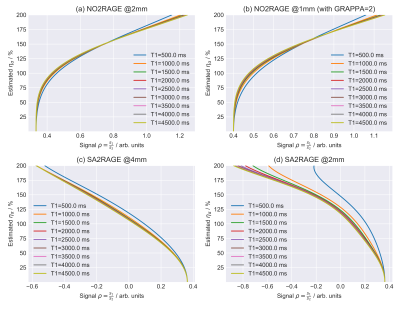
Fig.2: Simulation of Bloch equations for $$$B_1^+$$$ mapping.
The simulations show both the sensitivity to $$$B_1^+$$$ variations and $$$T_1$$$ insensitivity. The robustness against $$$T_1$$$ changes is very high for both NO2RAGE acquisitions and for the lower resolution SA2RAGE, while the higher resolution SA2RAGE, with delay times matching those from the original paper, is more sensitive to $$$T_1$$$. The acquisition parameters are (for NO2RAGE, $$$T_{D,i} = 0$$$):
- NO2RAGE @2mm: $$$\alpha_{1,2}=4,12°$$$, $$$T_{R,\mathrm{GRE}}=3.7\;\mathrm{ms}$$$, $$$n_\mathrm{GRE}=96$$$, $$$T_{R,\mathrm{seq}}=710\mathrm{ms}$$$;
- NO2RAGE @1mm (with GRAPPA=2): $$$\alpha_{1,2}=4,10°$$$, $$$T_{R,\mathrm{GRE}}=4.8\;\mathrm{ms}$$$, $$$n_\mathrm{GRE}=112$$$, $$$T_{R,\mathrm{seq}}=1080\mathrm{ms}$$$;
- SA2RAGE @4mm: $$$\alpha_{1,2}=4,11°$$$, $$$T_{R,\mathrm{GRE}}=3.5\;\mathrm{ms}$$$, $$$n_\mathrm{GRE}=48$$$, $$$T_{I,(1,2)}=101,1800\;\mathrm{ms}$$$, $$$T_{I,(1,2)}=170,2000\;\mathrm{ms}$$$, $$$T_{R,\mathrm{seq}}=2400\mathrm{ms}$$$;
- SA2RAGE @2mm: $$$\alpha_{1,2}=4,11°$$$, $$$T_{R,\mathrm{GRE}}=3.7\;\mathrm{ms}$$$, $$$n_\mathrm{GRE}=96$$$, $$$T_{R,\mathrm{seq}}=2700\mathrm{ms}$$$.
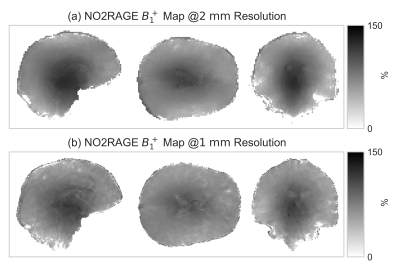
Fig.3: Relative $$$B_1^+$$$ maps obtained with the NO2RAGE pulse sequence.
Values are dimensionless and expressed in percent units (%). Both $$$2\;\mathrm{mm}$$$ and $$$1\;\mathrm{mm}$$$ isotropic resolution maps are shown after masking out non-brain tissues. The acquisition time was 01:08 min (with no acceleration techniques) and 03:31 min (using GRAPPA=2) respectively. The acquired images were median-filtered for denoising before the computation of the $$$B_1^+$$$ maps. For comparison, comparable $$$2\;\mathrm{mm}$$$ acquisitions would take 20:45 min for AFI and 4:48 min for SA2RAGE.
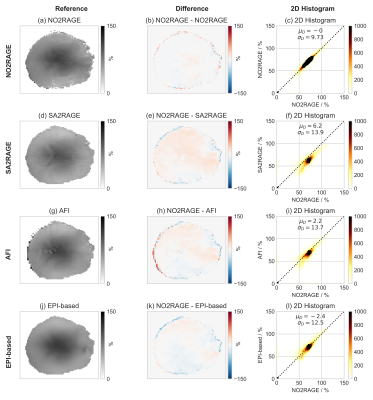
Fig.4: Comparison of NO2RAGE with other $$$B_1^+$$$ acquisition techniques.
The correspondence between the different acquisition techniques is very good, as clear from the values in the difference image and the proximity of the voxel-wise 2D histograms to the identity line. The results are compared at $$$2\;\mathrm{mm}$$$ resolution, for which only NO2RAGE was acquired, while the others were acquired at $$$4\;\mathrm{mm}$$$ resolution and upscaled (using nearest neighbor interpolation). The first line shows the results of the NO2RAGE test-retest comparison. Acquisition parameters for NO2RAGE and SA2RAGE are reported in Fig.2. AFI was acquired with $$$T_{R,(1,2)}=15,120\;\mathrm{ms}$$$ and $$$\alpha=60°$$$; EPI-based according to [8].
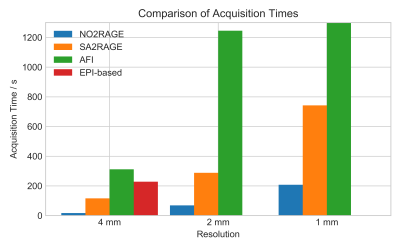
Fig.5: Comparison of acquisition times at different resolutions.
The NO2RAGE acquisition is much faster than the other considered methods. For example, the $$$1\;\mathrm{mm}$$$ NO2RAGE is faster than most $$$4\;\mathrm{mm}$$$ acquisitions (except SA2RAGE) and at $$$2\;\mathrm{mm}$$$ the NO2RAGE is four-times faster than SA2RAGE. Note that although the linear resolution is reported, the voxel volume scales cubically. The EPI-based method additionally requires a $$$B_0$$$ mapping for geometric corrections. For reference, a comparable double angle method (DAM)9 acquisition would require more than 3 hours (assuming $$$T_R=10\;\mathrm{s}$$$, and partial Fourier in both phase encoding directions).